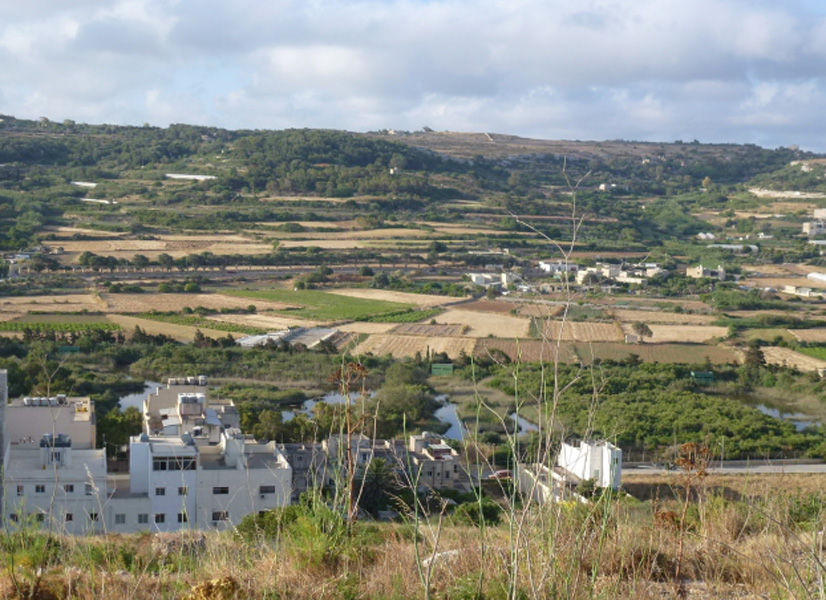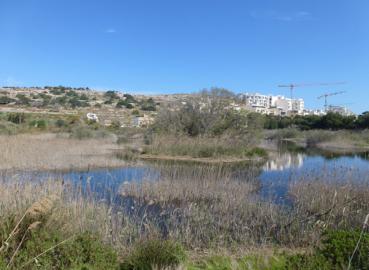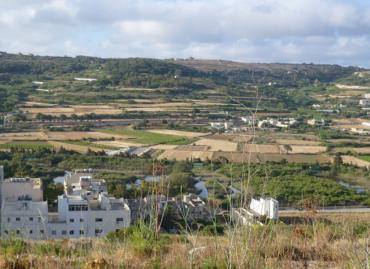MAL012 - Is-Simar
Description
Is-Simar wetland (limiti ta’ San Pawl il-Baħar) is found on the north-east coast of Malta. It is part of the St Paul’s Bay locality boundary and covers an area of approximately 0.6 km2. The site is found close to Xemxija and is in the Pwales Valley.To the east, the site borders Xemxija Bay whilst the west borders the Pwales agricultural area. To the south there is the Wardija Ridge escarpment and to the north there is the Bajda Ridge. The seaward area of the site borders Il-Grigal ta’ Malta Marine Protected Area.The site incorporates various features including an artificially created wetland habitat, which is fenced off and is located behind Xemxija Bay. It is a coastal site with brackish water pools. The wetland is surrounded by agricultural land that stretches west of the wetland. Is-Simar wetland falls within a Special Area of Conservation, a Special Protection Area, a Bird Sanctuary, Area of Ecological Importance and a Site of Scientific Importance. It is also one of two Ramsar listed sites in the Maltese Islands. The main hydrological feature is the Pwales Valley that is a fertile valley dominated by agricultural land.The hydrological and hydrogeological features comprise: 1) the semi confined aquifer of Wied tal-Pwales; 2) the watercourse and catchment of Wied tal Pwales and its tributaries; 3) private extraction in Wied tal-Pwales; 4) saline marsh at is-Simar which is a Wetland Reserve; and 5) diffuse discharge along the coastline into the bay away from the beach (Terracore 2013).The wetland provides an important habitat for several migratory bird species as well as wintering and breeding species. Species breeding at the site include the Reed Warbler, the Moorhen, the Common Coot, the Zitting Cisticola, and the Sardinian Warbler. The wetland also supports a good population of the Maltese Killifish, a species that tolerates extreme changes in its environment including temperature and salinity. The area provides important foraging ground for bats and certain cultural heritage features are known to provide suitable roosting habitat for the Lesser Horseshoe Bat. The only native amphibian species in the Maltese Islands, the Painted Frog, is present at the reserve.Is-Simar Wetland Reserve supports the most extensive Phragmites reed bed in the Maltese Islands. It is an ideal habitat for several marshland species, providing shelter and food for waterfowl, herons, rails and passerines. It also provides a unique breeding habitat for reed warblers, Little Bittern and moorhens. An old olive grove is located at the eastern part of the reserve, part of which is not, however, enclosed as part of the reserve. This grove naturally regenerates, the fruits are eaten and the seeds dispersed largely by the Common Starling. A few Mastic trees are also found growing naturally as undergrowth. This is an important habitat for migratory passerines and wintering species. The Pwales valley is a natural corridor through which birds are funneled during their passage over Malta. The presence of the wetland habitat together with the overlying Miżieb woodland upgrades this passageway into an invaluable feeding, resting and roosting stopover for all avifauna in both migration periods. The woodland habitat of Miżieb lies in a strategic place overlooking the valley and wetland and thus it is particularly valuable as a roosting site for raptors including Marsh Harrier, Honey-Buzzard, Black Kite and European Hobby, as well as herons. The woodlands also hold an array of other migratory species, including Turtle Dove, Golden Oriole and other species such as flycatchers, thrushes and warblers.The Miżieb woodland is also important for several breeding bird species. These include Sardinian Warbler, Zitting Cisticola, Blue Rock Thrush, Spanish Sparrow and Tree Sparrow. Several locally rare species also regularly attempt to breed in the woods, including Serin, Chaffinch, Turtle Dove, Collared Dove and Common Cuckoo. A number of activities exert pressure on the ecology of the site. The wetland is in the urbanised and frequented area of Xemxija, St Paul’s Bay and the Miżieb area resulting in pressure from recreational activities, vehicles (the reserve is close to a road), and development. The Miżieb woodland above the wetland is used and managed as a hunting reserve. As described above the site is of immense ornithological value and as a result, poaching is a factor that affects this site.

Wetland data
Basic information
| Wetland location: | Marine/Coastal |
| Wetland type: | Natural |
| Wetland area: | 4.10 Ha |
| Hydrological interaction: | - |
| Water salinity: | Brackish (5.0-18.0 g/l) |
| Type of fresh water input: | Catchment area (precipitation) |
| Surface water runoff | Outflow controlled by pipeline |
| Open water area (%): | 51 - 75 |
| Hydroperiod: | Permanent |
Geographic information
| Census district: | Northern |
| Island: | Malta |
| Local council: | San Pawl Il-Bahar |
| Longitude: | 14.381780 East |
| Latitude: | 35.945590 North |
Ramsar wetland type
| Type | Coverage (%) |
| J -- Coastal brackish/saline lagoons; brackish to saline lagoons with at least one relatively narrow connection to the sea |
Property status
| Public |
| Protection status category | Protection status subcategory | Area's name | Code | Coverage area (%) | Legislation |
| National | Area of Ecological Importance/Site of Scientific Importance | L-inhawi tas-Simar mit-Triq tal-Mizieb sa Xatt il-Pwales, limiti ta' San Pawl il-Bahar | 346036 | 100 | Development Planning Act (Act VII of 2016) |
| National | Bird Sanctuary | Il-Madwar tas-Simar, fir-Ramla tal-Pwales, San Pawl il-Bahar | 14794 | 100 | Environment Protection Act (Act I of 2016) |
| International | Special Areas of Conservation - International Importance | Is-Simar (l/ta' San Pawl il-Bahar) | 330720 | 100 | Environment Protection Act (Act I of 2016) |
| International | Special Protection Areas | Is-Simar (limiti ta' San Pawl il-Bahar) | 555552402 | 100 | Environment Protection Act (Act I of 2016) |
| International | Ramsar Sites | Is-Simar | 100 | ||
| International | Transitional waters | Is-Simar | MT TW 04 | 100 | Water Framework Directive |
CDDA protection status
| CDDA code | CDDA category |
| MT02 | Area of Ecological Importance/Site of Scientific Importance |
| MT03 | Bird Sanctuary |
| MT11 | Special Areas of Conservation - International Importance |
| MT13 | Special Protection Areas |
Ecosystem services
| Type of ecosystem service | Ecosystem service | Scale of Βenefit (%) | Importance |
| Cultural services | Cultural heritage | ||
| Regulatory services | Flood hazard regulation | ||
| Supporting services | Provision of habitat | ||
| Cultural services | Recreation and tourism |
Activities on wetland
| Activity | Intensity |
| 010 = Habitat conservation | High |
| 020 = Resource conservation | High |
| 030 = Species conservation | High |
| 610 = Interpretative centres | High |
| 853 = management of water levels | High |
| 952 = eutrophication | Medium |
Activities on catchment area
| Activity | Intensity |
| 010 = Habitat conservation | High |
| 020 = Resource conservation | High |
| 030 = Species conservation | High |
| 100 = Cultivation | High |
| 110 = Use of pesticides | High |
| 120 = Fertilisation | High |
| 130 = Irrigation | High |
| 230 = Hunting | High |
| 243 = trapping poisoning poaching | Low |
| 430 = Agricultural structures | Medium |
| 502 = roads motorways | High |
Impacts
| Impact | Intensity |
| EB- = Increase in aesthetic qualities | High |
| ER- = Increase in flow regulation | High |
| ES- = Increase in water supply | High |
| EU- = Increase of tourist/recreation potential | High |
| EW- = Increase in wilderness/wildlife values | High |
Habitat types
| Type | Coverage (%) |
| 1150 * Coastal lagoons | 26 - 50 |
Adi Epsilon Consortium (2014b) Is-Simar – Natura 2000 Management Plan (SAC). Prepared for the Malta Environment and Planning Authority under CT3101/2011. San Gwann, Malta, pp. 112 + Annex
BirdLife Malta – Simar Wetland Reserves Work Plan 2011-2012
BirdLife Malta (2010) Mizieb Report
BirdLife Malta (January – June 2011) Final Management Effectiveness Report: Simar Wetland
Coleiro, C. and Casha, A (2004) Is-Simar Special Area of Conservation: management Plan for Simar Wetland Reserve 2004/2008
Deidun, A., Diacono, I., Tigano, C. & Schembri, P.,(2002) Present distribution of the threatened killifish Aphanius fasciatus (Actinopterygii, Cyprinodontidae) in the Maltese Islands. Central Mediterranean Naturalist, 3(4), pp. 177-180.
ERA (2015) The 2 nd Water Catchment Management Plan for the Malta Water Catchment District 2015 - 2021
Friggieri, I. (1999) Simar Nature Reserve. Dip Env. Sci.
Seguna, A. (1995) The vegetation of Is-Simar : a wetland reserve in the making. B.ED (HONS) Dissertation UoM
Zammit-Mangion, M. & Deidun, A., (2010) Management Recommendations For The Conservation Of Threatened Aphanius Fasciatus NardoPopulations From Two Wetlands In The Maltese Islands. s.l., s.n., pp. 356-357.
Zammit-Mangion, M. (2009) Action Plan for Aphanius fasciatus at the Għadira Nature Reserve and the Simar Bird Sanctuary.



